Morocco cuts energy subsidies
In the wake of the international financial crisis and the Arab Spring, Morocco has started running ever-widening fiscal and current account deficits. However, moves to slash energy subsidies, as well as the fall in international oil price, have helped to dramatically reduce both, boosting liquidity and exchange reserves. This has allowed the government to increase its focus on investment. Over the long term, the continued development of export-oriented industry, as well as plans to boost the role of locally generated renewable energy to replace costly fuel imports, should help keep a lid on the current account deficit (CAD).
Fiscal Deficit
The government has been running a budget deficit annually since 2009. The shortfall peaked in 2012 at nearly 7% of GDP, according to figures from the Ministry of Economy and Finance (Ministére de l’É- conomie et des Finances, MEF). However, in large part due to recent moves to cut fuel subsidies, this figure fell to 5.1% in 2013. Thanks to further subsidy cuts and lower international energy prices, the deficit declined even further to 4.9% in 2014. In October 2014 the IMF forecast the figure at 6.8% of GDP in 2014, falling to 5.8% in 2015 and 5.1% in 2016, higher than government estimates. Speaking in January 2015, Ahmed Lahlimi Alami, head of the High Commissioner of Planning, forecast the 2015 deficit to stand at 4.5%.
With most fuel subsidies having now been removed, the fall in the price of oil is not entirely good news for the Moroccan Treasury. The MEF expects the price drop will result in a Dh3bn (€326.4m) fall in value-added tax receipts in 2015. However, the drop in energy prices should reduce the cost of the heating gas subsidies still in place, which should more than make up for this.
“The 2015 Finance Law foresees Dh23bn [€2.5bn] in spending for subsidies; however, the final bill should be around Dh5bn [€544m] lower than that because of low oil prices,” said Karim Gharbi, head of research for capital markets at Moroccan investment Bank CFG.
The authorities are also working on a way to better target butane subsidies, which are aimed at poor households but which some firms are increasingly taking advantage of at the expense of the state.
The government’s long-term goal is to limit the deficit to 2.8% of GDP by 2018. “A fiscal deficit of around 3% is sustainable,” said Gharbi. “A country at Morocco’s stage of development should not be running budget surpluses.” However, he added that the focus of deficitfinanced spending should be on investment and that further reforms would be necessary to achieve this. Gharbi told OBG, “The government wage bill is still high – even if the overall deficit falls under 3%, there would still be room to restructure spending.”
Current Accounts
The fall in energy prices is also helping to reduce the CAD, which entered negative territory in 2008 for the first time since 2000 due to a high import bill and a fall in exports to the EU, peaking at 9.7% in 2012 and settling at 6.8% in 2014, according to IMF figures. However, the number has been declining since then and is set to continue to do so in 2015. “Lower energy prices should knock around Dh15bn [€1.6bn] off the deficit, which will represent around 4.5-5% of GDP in 2015,” said Gharbi, adding that the primary factor underpinning its persistence was the country’s trade deficit. He told OBG, “Morocco is behind in regards to developing high-added-value exports. We import smartphones while exporting phosphates.”
However the situation appears to be improving thanks to positive results from the kingdom’s sector development strategies. Gharbi said, “Exports of cars exceeded those of phosphates for the first time in 2014, and growth in other sectors, such as aeronautics and offshoring, is also helping to reduce the deficit.” Signs of economic recovery in key European trading partners such as Spain should help to reduce the CAD. Another positive boost is expected from rising remittances, which were worth Dh59.13bn (€6.43bn) in 2014, up from Dh57.86bn (€6.29bn) in 2013, and tourism receipts, with Europe being the largest source market and bringing in Dh57.4bn (€6.24bn) in 2014, barely changed from Dh57.61bn (€6.27bn) the previous year.
You have reached the limit of premium articles you can view for free.
Choose from the options below to purchase print or digital editions of our Reports. You can also purchase a website subscription giving you unlimited access to all of our Reports online for 12 months.
If you have already purchased this Report or have a website subscription, please login to continue.

